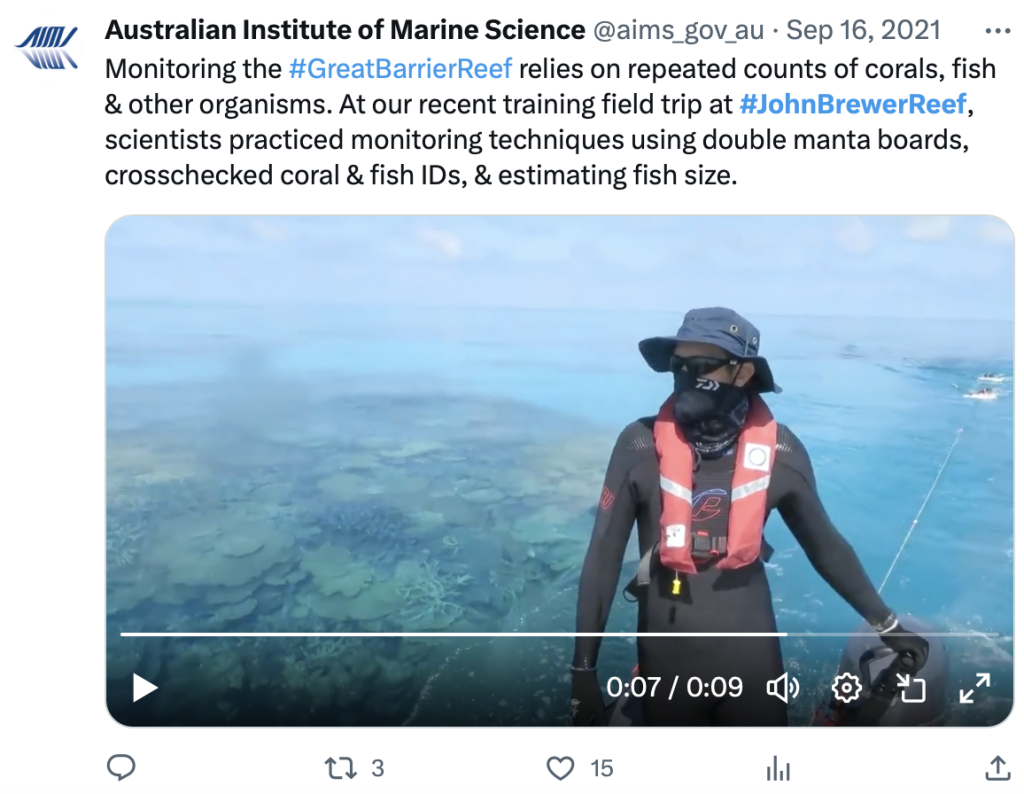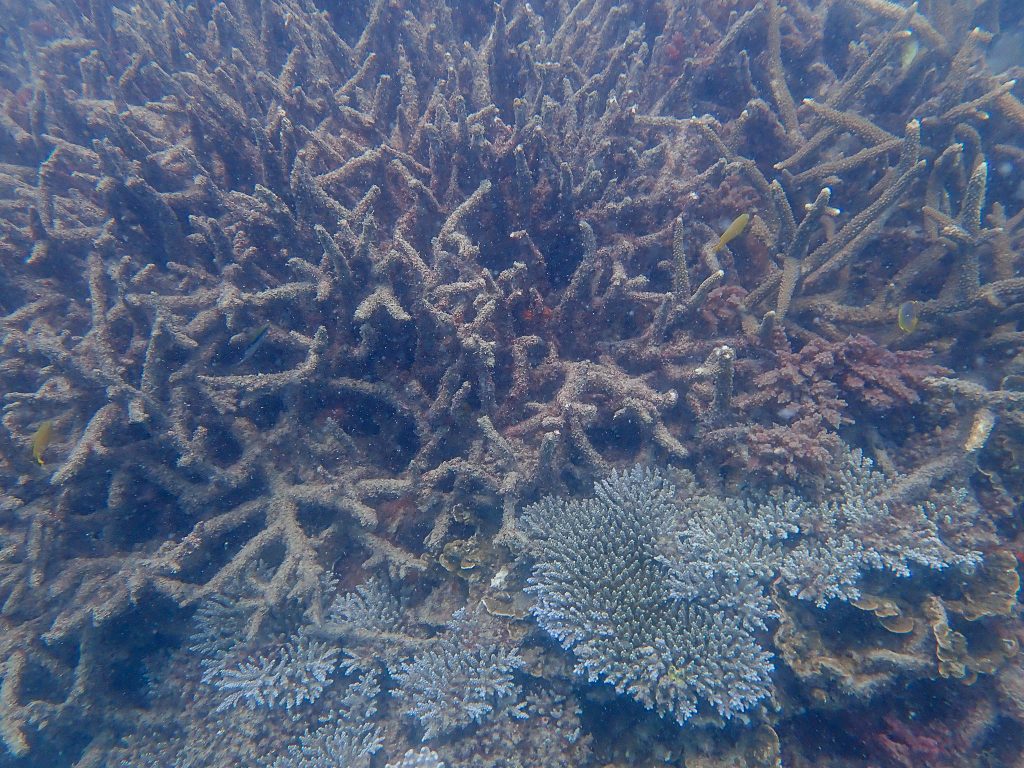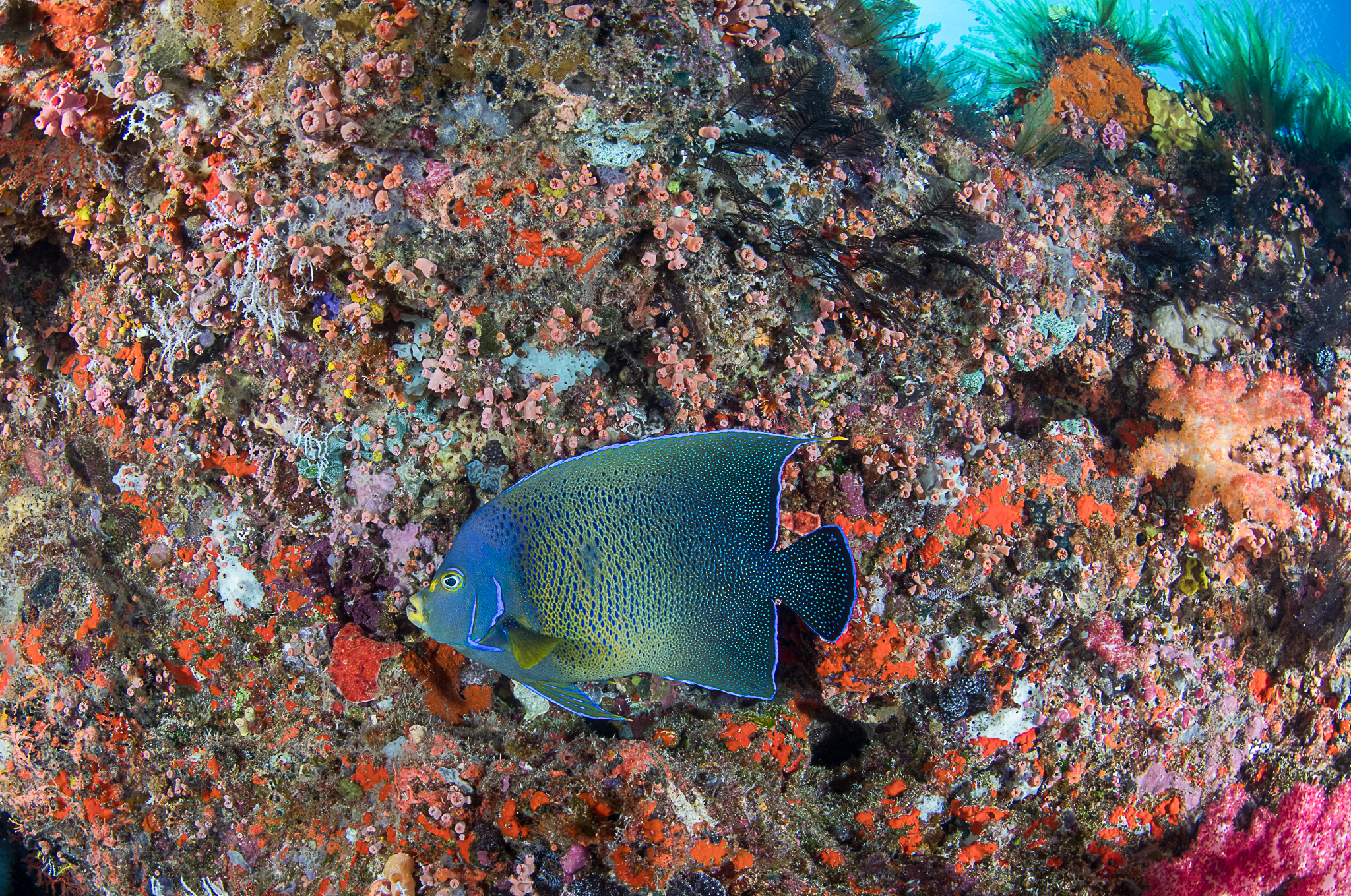The Australian Institute of Marine Science (AIMS) put out a media release earlier today claiming to have scientifically documented changes in coral cover for the northern section of the Great Barrier Reef, particularly in the vicinity of Lizard Island. Claims include that:
The losses of coral we’ve recorded so far are significant. Despite these losses, coral cover on most reefs is at moderate levels of between 10 and 30%.
In fact, the method used to survey the corals makes it impossible to determine whether the loss is statistically significance or not, and the surveys were only of the reef perimeters, specifically avoiding habitats with higher levels of coral cover including the reef crest. So, claims that coral cover is between 10 and 30% really needs to be qualified.

Many textbooks have been written about the type of survey needed to know if there is a statistically significant change in some aspect of the distribution and abundance of an organism. This could be the population of a city, or even the extent of coral at the Great Barrier Reef. Knowing the distribution and abundance of organisms and how this might change over time is fundamental to understanding the world around us. It is fundamental to the biological sciences.
Rarely is it possible to count every person or every coral. Instead, scientists rely on samples that must be representative of the entire population of interest, and samples must be large enough to generate meaningful data that gives unbiased results.
A population will always include some natural variability and knowing how this is distributed in space and time is important before any conclusions are drawn about the significance of a perceived increase or deterioration, for example, in the corals.
Importantly, in order to be able to quantify statistical significance the data needs to be gathered as an actual count. By which I mean the number of corals needs to be counted per unit area, and given the extent to which coral cover changes naturally with habitat it is important that the survey method distinguishes between the different habitats at a reef.
Of concern, the long-term monitoring being undertaken by the Australian Institute of Marine Science (AIMS) of coral cover is by way of perimeter surveys that do not include, for example, the reef crest that is often the habitat with the highest coral cover. This is the equivalent of claiming to know how the population of a city has changed but never actually going into the central business district (CBD) or even the inner-city suburbs or industrial area. The AIMS surveys that have been reported upon in the media today are surveys of only the reef perimeter, which is the equivalent of skirting around the outer suburbs of a city and from this limited information having an opinion about how the population of a city might have changed.
It is also very important to note that the data is not collected as an actual count. Rather AIMS coral cover data is categorical data, with the survey collected by towing a person behind a boat and noting whether the extent of the coral cover falls into one of the following categories: 0-10%, 10-30%, 30-50%, 50-75%, 75-100%.
These categories have a very large range, up to 25%. It doesn’t matter how many surveys are undertaken, given the way the data is collected it is impossible to calculate average coral cover. It follows that it will be impossible to know how average coral cover changes.
Because the AIMS coral cover data is categorical data it is not possible to calculate a standard error or any other such statistic. Calculating an uncertainty value, for example a standard error, depends on knowing the sample mean. The method used by AIMS precludes this, it is therefore not possible to draw any conclusions about the statistical significance of the recent survey results.



 Jennifer Marohasy BSc PhD is a critical thinker with expertise in the scientific method.
Jennifer Marohasy BSc PhD is a critical thinker with expertise in the scientific method.

Hi Jennifer
I’m wondering whether you have ever come across the use of NDVI imagery (or relatives like NDRE) in the study of coral cover? It seems to me that drone mounted multispectral sensors like these, as I use in agricultural cropping field trials, would have the potential to provide a far more reproducible and accurate method of large scale reef cover and health assessment than the labour-intensive, direct observational estimation methods you describe, as used by AIMS.
I’ll take the assessments of well resourced and independent scientists over biased recreational divers and bloggers.
The recent documentation of what is purported to be the largest coral ever discovered (off the coast of the Solomon Islands, estimated to have been growing for between 300-500 years) – begs one or two questions about the ‘destructive’ influence of Global Warming on coral growth.
The discovery of a large coral is meaningless when compared with rigorous survey data.
Yes, Karen – unfortunately, photographic evidence is rendered meaningless, when compared with concocted survey data by certain vested interest groups.
Jen, agree with you about sampling. I have several books on sampling. I was on AS MN/1 committee on mineral sampling. I was the chairman of AS MN/7/5 committee which wrote a standard on Acceptance testing of refractories by variables. There are a number of important feature 1/ testing needs to cover the whole area, population, batch etc of what you are testing b/ it needs to be random -not just areas or portions accessible, 3/ there needs to be sufficient significant number of samples for statistical analysis, 4/ testing must be reproducible – not by observation that maybe biased (photos which could be analysed by different operators could be one way of testing or robotics like facial recognition) 5/ It is best to do more than one sampling set so errors can detected in the sampling plan. Sampling can be expensive but one must always consider that a chain is only as good as the weakest link. In refractories just one unit (brick) can lead to a collapse and cost millions.
It seems to me that millions have been wasted on unnecessary and meaningless research on the GBR. My daughter’s research has been on defenses of marine creatures, possible medicines for humans, diseases affecting farmed fish and shellfish (eg oysters) etc. She has written over 200 papers and book articles- many with students she supervises. Academia, at the present time, does not allow free speech about sea levels, global warming, ocean pH, ENSO, SOI, AGW etc.unfortunately, our conversations avoid the latter subjects and I have to us a pseudonym.
‘The long-term timing of spawning may be related to temperature, day length, and/or rate of temperature change (either increasing or decreasing). The short-term (getting ready to spawn) timing is usually based on lunar cues, or cues from the moon. The final release, or spawn, is usually based on the time of sunset.’ (NOAA)
Are Corals all Judeo Christians ?
The only ‘calendar’ that can accommodate the observed behaviours apparent in the natural world, is the Earth/Solar Orbital Calendar.
There are ALWAYS 360 Day/Night Intervals per Earth/Solar Orbital Year.
The Earth moves through one degree of Solar Longitude each Day/Night Interval.
The Earth turns on its Axis through 360 degrees, once every Day/Night Interval.
The Earth’s Angle of Obliquity gives us 4 Seasons of equal duration.
Reject the Fabricated Lie that is the Judeo Christian (Gregorian) Calendar – and remove Religion from this Planet.
Much thanks to Anthony Watts and Charles Rotter for republishing me at WUWT, link here: https://wattsupwiththat.com/2024/11/19/reflections-on-claims-about-coral-cover-part-1/
And I appreciate the discussion in the thread that follows, specifically about the mathematics that can and cannot be applied to categorical data in an attempt to extract some uncertainty value and all its limitations. To be sure, you cannot credibly generate an uncertainty value from such data as I have been explaining to Peter Ridd for many years.
It saddens me to the core that AIMS continue with their nonsense surveys at great expense to the Australian tax payers. But the AIM scientists at least do not apply an uncertainty value to this data. They understand the limitations of categorical data when it comes to determining statistical significance.
It saddens me that the IPA continue to back Peter Ridd, and have not removed his nonsense charts with a +/- 4% invented uncertainty value against this same data. There should at least be some warning associated with his presentations, for example, https://ipa.org.au/research/climate-change-and-energy/dr-peter-ridd-culture-wars-on-the-great-barrier-reef-ipa-academy, explaining that the SE as shown in the charts was not actually calculated from the mean values as shown.
I have gone to so much trouble particularly since September 2023 when it became apparent that there was an expectation I would publish Peter Ridd’s ‘record coral cover’ chart as part of his chapter in the next book in the ‘Climate Change: The Facts’ series … I have gone to so much trouble to explain the associated statistics including: 1. the importance of generating a standard error from the data at hand if one is going to be shown on a chart, and 2. the limitations of any such endeavour when the data is categorical.
I am proud that as one of the editors of the newly launched ‘Climate Change: The Facts 2025’ I refused to publish Ridd’s invented nonsense chart and as a consequence Peter Ridd does not have a chapter in that book.
It is unfortunate that as a consequence I have not been invited to any of the many launches of this book by the IPA. A small price to pay for ensuring some integrity in that important series.
Unfortunately the IPA project as a ‘cabal’ of Religious Right apologists. As such, they lack the intellectual capacity to recognise what is actually happening in the natural world – and refuse to acknowledge that their religious antecedents leave them with nowhere to turn but back on themselves, when confronted with Reality.
The Cyclic/Orbital Mechanisms and Set Timeline Frequencies of Solar-induced Temperature Fluctuations reaching the Earth’s Surface, means Humankind does not have ‘God on its side’. This includes every religious denomination and sub-group – and every ‘cargo-cult’/witch-doctor iteration, since humans achieved upright posture and sallied forth to ‘multiply’, at the expense of everything in their path – confident in their fabricated self-seeking, self-imposed ignorance.
Humankind alone, has responsibility for the ongoing stewardship and preservation of the Planet and its species – in perpetuity(or however long it lasts.)
It is time for Science (and scientists,) to show (lacking until now) leadership – reject the ‘priest-generated’ Gregorian Calendar – and adopt a belief system, relevant to the actual workings of the Natural World.
The only well resourced scientists are those working for governments living off the taxpayers and they are certainly not independent or accountable. Their survey methods are demonstrably defective, often more useless than if they were not done at all – aerial surveys being particularly absurd.
The most rigorous surveys are more often those done by non-government scientists who are as well educated as the government ones, and often with far more practical knowledge and not constrained by the diktat of the pseudo-scientific ‘consensus’ which has little to do with actual science. In any official organisation there are certainly diligent and honest scientists trying their best but they invariably run into the brick wall of the ‘official’ view. That is no different to the UN and IPCC where over several decades hundreds of ethical scientists have left in disgust at having their contributions to the Working Group reports amended for political reasons and sometimes to say the exact opposite of what they had written.
Putting a number on coral cover is a fraught question and can be almost as meaningless as average global temperatures (notwithstanding the well publicised tampered data). Whilst it is to some extent a necessary or desirable objective in genuinely trying to understand the rather obvious cyclical nature of reefs (as for almost any species) it has to be tempered with recognition of the difficulty of sampling enough locations annually and also the relative variations. Some reefs are in locations that allows more extensive growth and therefore relatively high cover whilst others have much less growth and cover but are no less healthy than their richer cousins. Richness and health assessment is a very subjective and comparative measure. A reef that has just suffered a COTS infestation or cyclone is simply going through a natural cycle and may be just as healthy on a long-term basis as nearby reefs that have avoided those events – their turn will come in the normal ebb and flow of nature.
Regrettably, some commentators seem more interested in repeating propaganda than showing a genuine scientific interest and are so repetitive that I sometimes wonder if they are in fact Google robots stuck in a loop.